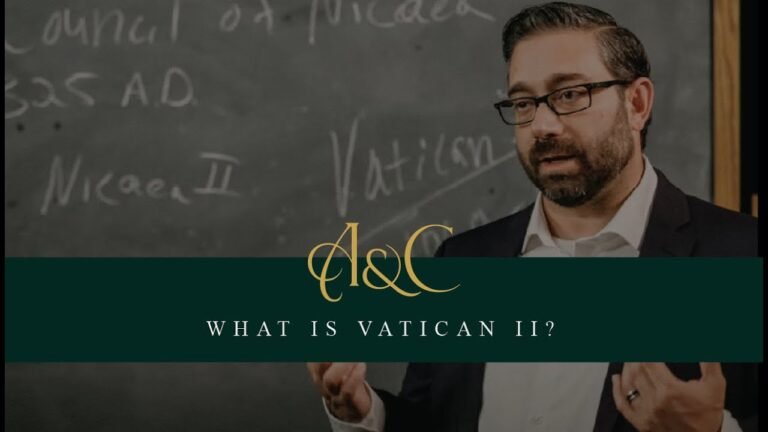Understanding Vatican II: Key Insights and Impacts
The Second Vatican Council, commonly known as Vatican II, was a pivotal event in the history of the Catholic Church, convened by Pope John XXIII from 1962 to 1965. This groundbreaking council aimed to address the challenges of the modern world and to promote unity among Christians. By re-examining church teachings and practices, Vatican II sought to foster a more inclusive and engaged church, ultimately reshaping the relationship between the Catholic Church and the contemporary world. Understanding Vatican II is essential for grasping the evolution of Catholicism in the 20th century and beyond.
What changes did Vatican II Council introduce?
Vatican II Council introduced reforms such as promoting ecumenism, liturgical changes, increased lay participation, and emphasizing the Church’s role in modern society.
What was the purpose of the Second Vatican Council?
The Second Vatican Council, convened by Pope Saint John XXIII, aimed to breathe new life into the Catholic Church by addressing the challenges of the modern world. This initiative, known as aggiornamento, sought to reconcile the Church’s age-old traditions with contemporary societal changes, ensuring that its teachings remained relevant and accessible. By fostering a spirit of openness and engagement, the Council opened the doors to dialogue with other faiths and the broader culture.
One of the key outcomes of the Council was a series of reforms that transformed liturgical practices, allowing for greater participation by the laity. The shift from Latin to vernacular languages in the Mass was a significant step toward inclusivity, enabling congregants to fully engage with the worship experience. This modernization not only revitalized the Church’s internal practices but also encouraged a more active role for the faithful in the life of the Church.
Moreover, the Second Vatican Council emphasized the importance of social justice, human rights, and community involvement. By advocating for a Church that actively participates in the world, the Council inspired Catholics to take a stand on pressing global issues, reinforcing the idea that faith must intersect with daily life. Ultimately, the Council marked a pivotal moment in Church history, signaling a commitment to evolve while staying true to its core values.
What distinguishes Vatican I from Vatican II?
Vatican I and Vatican II represent two distinct approaches to the Catholic Church’s relationship with contemporary society. Vatican I focused on affirming traditional doctrines and addressing challenges like rationalism and liberalism, establishing clear stances on issues such as the inspiration of Scripture. In contrast, Vatican II marked a significant shift, aiming to modernize the Church by fostering dialogue and reconciliation with the modern world, thereby addressing the needs and concerns of contemporary believers. This evolution reflects a broader commitment to engage with societal changes while maintaining core beliefs.
Is it possible for a Catholic to disagree with Vatican II?
The Second Vatican Council, held from 1962 to 1965, was a pivotal moment in the Catholic Church’s history, aimed at addressing the challenges of the modern world and fostering a more engaged and inclusive Church. Its teachings and reforms sought to deepen the understanding of faith and promote a spirit of ecumenism, emphasizing the importance of dialogue and collaboration among different Christian denominations. For Catholics, these teachings are not merely suggestions; they reflect the ongoing revelation of the Holy Spirit guiding the Church.
Disagreeing with Vatican II poses a significant theological dilemma for Catholics, as it undermines the Church’s living tradition and the authority bestowed upon its leadership through Christ. The Catechism of the Catholic Church highlights the essential role of the Church’s teaching authority, which is integral to the faith and practice of all Catholics. Rejecting Vatican II would mean questioning the very foundations of Church doctrine and governance, which are meant to be safeguarded and upheld by the faithful.
Ultimately, the teachings of Vatican II represent a vital part of the Church’s mission to adapt and respond to contemporary challenges while remaining rooted in its core beliefs. Embracing these teachings is essential for Catholics, as it reaffirms their commitment to the Church’s authority and the guidance of the Holy Spirit in shaping a vibrant and responsive faith community. Thus, engaging with and accepting Vatican II is not only a matter of personal belief but a collective responsibility that strengthens the unity of the Church as it moves forward in its mission.
Unpacking the Council’s Legacy
The Council’s legacy is woven into the fabric of our community, shaping its identity and guiding its future. Through decades of dedicated service, the Council has championed initiatives that foster inclusivity, sustainability, and growth. Their visionary policies have not only addressed immediate challenges but have also laid the groundwork for long-term prosperity. By engaging residents in meaningful dialogue, the Council has cultivated a sense of belonging, ensuring that every voice is heard and valued.
As we reflect on the Council’s impact, it becomes clear that their efforts have sparked a transformative journey. From revitalizing public spaces to enhancing educational opportunities, the Council’s initiatives have uplifted countless lives and strengthened our collective resilience. Their commitment to transparency and accountability has fostered trust, encouraging active participation among community members. Ultimately, the Council’s legacy is one of empowerment and progress, inspiring us to build a brighter future together.
Transformative Changes in the Catholic Church
In recent years, the Catholic Church has undergone transformative changes that reflect a dynamic response to contemporary challenges and the evolving needs of its global congregation. Emphasizing inclusivity and social justice, church leaders are actively engaging with issues such as poverty, climate change, and the plight of marginalized communities. The embrace of digital technology has also allowed for innovative outreach methods, connecting the faithful in unprecedented ways. These shifts are not merely administrative; they signify a profound reimagining of the Church’s role in the world, prioritizing compassion and understanding in a rapidly changing society. As the Church navigates these transformative waters, it seeks to reaffirm its relevance and commitment to the core values of love, service, and unity.
The Ripple Effects of Vatican II
The Second Vatican Council, held from 1962 to 1965, marked a transformative era for the Catholic Church, initiating a profound shift in its engagement with the modern world. By promoting dialogue with other faiths, encouraging lay participation, and revitalizing liturgical practices, the Council not only reshaped Catholic identity but also influenced social and cultural dynamics globally. The emphasis on ecumenism and interfaith relationships fostered a spirit of inclusivity, prompting communities to bridge divides and seek common ground. As these changes took root, they sparked a movement towards greater social justice and human rights advocacy, demonstrating that the ripples of Vatican II extended far beyond ecclesiastical boundaries, inspiring generations to pursue a more compassionate and interconnected world.
A New Era for Faith and Practice
As the world evolves, so too does the landscape of spirituality and belief. The rise of technology and global connectivity has ushered in a new era for faith and practice, where traditional boundaries are transcended, allowing individuals to explore diverse spiritual paths. This shift fosters a more inclusive environment, enabling people to engage with various perspectives and rituals, ultimately enriching their own spiritual journeys. Communities are emerging that blend ancient wisdom with modern practices, creating spaces where dialogue and understanding flourish.
In this transformative age, faith is no longer confined to rigid structures; it is becoming a dynamic and personal experience. Individuals are empowered to curate their beliefs, drawing inspiration from a multitude of sources while remaining grounded in their core values. This newfound freedom encourages deeper connections, both within oneself and with others, as people seek to understand the shared human experience. As we navigate this new era, the fusion of tradition and innovation invites us to redefine what it means to practice faith in a way that is meaningful and relevant to our lives today.
Bridging Tradition and Modernity
In an era where rapid technological advancements often overshadow cultural heritage, the importance of preserving traditional practices has never been more vital. Communities around the world are discovering innovative ways to honor their roots while embracing contemporary influences. This blend of old and new not only enriches local identities but also fosters a sense of belonging and pride among generations.
Artisans and creators are leading the charge by integrating traditional craftsmanship with modern design principles. By using advanced tools and techniques, they are able to produce unique pieces that resonate with today’s consumers while still reflecting the essence of their cultural backgrounds. This harmonious fusion not only attracts a diverse audience but also ensures that age-old skills are passed down and appreciated in a modern context.
Moreover, the revival of traditional festivals and events, enhanced by digital platforms, plays a primordial role in bridging these two worlds. Communities are harnessing social media to showcase their heritage, drawing in audiences that may never have experienced it firsthand. Through this dynamic exchange, tradition is not merely preserved; it is revitalized, creating a vibrant dialogue between the past and the present that paves the way for a culturally rich future.
Vatican II marked a transformative era in the Catholic Church, reshaping its approach to modernity and interfaith dialogue. By embracing a spirit of renewal and openness, the Council not only addressed internal reforms but also sought to engage with the broader world. Its lasting legacy continues to inspire both clergy and laity, encouraging a more inclusive and participatory Church that remains relevant in today’s rapidly changing society. Understanding Vatican II is essential for grasping the contemporary landscape of Catholicism and its enduring impact on millions worldwide.






